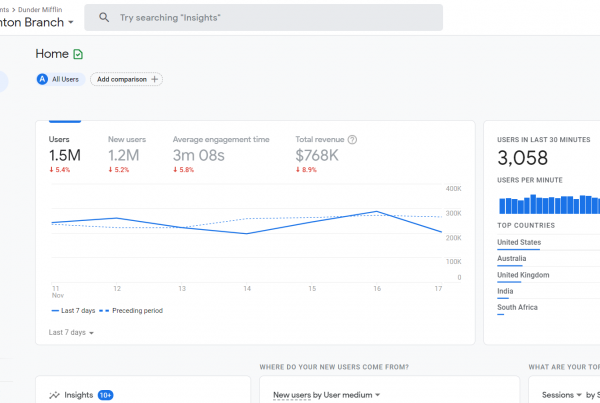
Google Analytics is a fantastic tool for all business owners with an online presence. There is a wealth of vital data you can attain regarding your user behaviors, which you can use to increase revenue in your business. From which pages or products have the most views to how long users browse and where they came from in the first place, Google Analytics can tell you this information.
We’re going to dive into the benefits of the platform and how you can utilize it to your advantage.
Regardless of your business model, using the AARRR framework will allow you to understand your business and your clients on a deeper level. While the structure was built for startup companies, it is beneficial through all stages of your business development.
What is AARRR Framework (or Pirate Metrics)?
- Acquisition: Potential clients visit your website, coming from a variety of channels.
- Activation: Visitors register or subscribe.
- Retention: Subscribed users return to your site.
- Referral: Users tell others about your business.
- Revenue: Users purchase your product or service.
Using this AARRR framework, you can accurately measure your sales funnel and assess where there may be problems and missed opportunities.
Acquisition
Acquisition will help you identify how the majority of your visitors are finding you. It’s an essential piece of information that will let you know which of your marketing efforts are paying off and which you can probably let go of. Maybe you’re putting energy into maintaining a presence on Twitter, but the majority of your visitors are coming in through Facebook.
Google Analytics will further break down these visitors to assess whether they are your target market and converting into quality clients. You may have tons of visitors coming from Reddit, but they may all drop off before actually purchasing or subscribing to your service. Therefore, it wouldn’t make sense to focus on marketing on Reddit, since the visitors aren’t resonating with your business.
Traditionally, marketers have always focused on this metric. You can identify whether the visitors have found you through affiliate links, TV or print ads, social media, organic search, and more. Any place that someone can see your business would be an acquisition.
The metrics should allow you to assess not only the channel in which they reach your business but also the quality of the visitor. Quality is represented by page visits, time viewing content, click-throughs on products, etc. It will help you analyze user behavior and is easy to track through Google Analytics.
You can view reports which will separate your visitors by channel. You can find this type of report under the “acquisition” menu.
The most beneficial reports you’ll want to focus on are:
- Channels: How are visitors reaching your website?
- Bounce Rate: How many visitors leave the site after the first page?
- Mobile (Overview): How many visitors are viewing your website on mobile?
- Browser & OS: Which browsers are visitors viewing your site on?
- Landing Pages: Which of your pages are attracting the most visitors?
Activation
So now, the visitors are aware of your business, and they have made it to your website. Now it’s about getting them to engage with your brand. The main focus of this step is to convert those visitors into clients.
You’ll want to look at the metrics which represent how successful particular channels and campaigns have been, which is represented by conversions. An easy way to start is to look at those clicking through onto your sign-up page. These visitors have shown interest or seen value in your brand and want to know more.
Whether they sign up to your newsletter or try out your product via a trial, it is considered activation. Though the user may not have purchased anything, yet they have made it to the next stage of your funnel.
Here is your chance to analyze these users to see what will make them purchase your product or service. You can use A/B testing and try out different written or visual content to see what resonates with your activated users.
The reports you’ll want to use when analyzing activation are:
- Pages/Sessions: What are your average page views per session?
- Bounce Rate vs. Benchmark Rate: What’s the bounce rate of your website, and how does it compare to others?
- Engagement: How long do visitors stay on your website?
- Users Flow: Which pages do users click-through?
- Exit Pages: On which pages do users stop browsing and leave your site?
- Click-through Rate: How many users come to your website to subscribe compared to those who just land there?
The above information will allow you to identify quality visitors as well as what makes them sign-up vs. what is preventing them from signing up.
Retention
It’s all well and good to sell one product or have someone subscribe to your service, but the key to business success is retention. You want to build a relationship with your clients to ensure repeat business. Retention is harder to track and is different for each company, depending on your AARRR framework.
Let’s look at a free mobile gaming app as an example. Free mobile games make revenue from ads, so you should track daily users, as they will dictate your income. Growing a free app can only be done when you have users who continue to play and watch the ads.
For a SaaS business, it’s very important to track churn data. Churn means a subscriber either quits their subscription or downgrades to a cheaper/free plan. Knowing this information can help your business reduce this from happening.
If you’re an eCommerce brand selling a seasonal product, for example, bathing suits, you’ll want to track which customers are returning the following season to repurchase.
Adopting a strategy for customer retention is crucial to your success. The filters you’ll want to use to measure retention are:
- New vs. Returning: How many visitors are brand new, and how many have interacted with you before?
- Active Users: How many visitors total have visited your website within a set number of days?
- Lifetime Value: How valuable are your users based on their interactions within the last 90 days?
Referral
While it’s great to gain exposure and new clients, the real value lies in retaining your loyal customer base. People that already know and love your brand will then act as your advertising when they mention you to others. It’s an organic and effective way to generate new business.
But what’s their incentive to rave about you to their friends? Well, there needs to be a strategy behind this. Offering incentives for customers to refer to others is a great option, but often hard to measure.
It’s quite complicated to build a metric that will accurately measure referrals as well as offer credit to those who referred them. It’s challenging to analyze the effectiveness of your referral campaign, as well.
If you use referral codes, for example, to track referrals, it’s essential to know how many codes are sent out compared to how many are accepted. That way, you can identify approximately how many referrals you are getting per customers. If you aren’t getting many, then you may need to up the incentive. You can use tools like Amplitude or Mixpanel to do these types of calculations for you.
Revenue
The moment we’ve all been waiting for is here. It’s time to talk about revenue. Every type of business, even ones that are, on the surface, non-monetary, needs income to be successful. For all startups, it’s essential to find out a way to monetize your business so that you can continue to operate. Massive platforms like Facebook and Instagram may have begun as purely social platforms but are kept alive by advertising.
How can you increase your revenue? Well, if you’ve been working on optimizing with the other portions of the AARRR framework already, then you should be well on your way. That said, the best way to see a boost is to increase your Customer Lifetime Value and decrease your Customer Acquisition Cost.
The Customer Lifetime Value or CTV measures how much revenue you make from each customer through their whole time interacting with your brand.
The Customer Acquisition Cost, or CAC, is how much your company spent to gain that customer. It would include any revenue spent on advertising, sales, business meetings, or dining out to convert them to a customer.
Ideally, your LTV to CAC ratio should be around 3:1. The best way to lower your CAC is to make your sales funnel more effective.
Reaching the revenue stage is different for each type of business. If you’re an eCommerce business, then it’s when someone purchases a product. For SaaS, its when your customer pays for their subscription. For consultancy, it might be when you receive a deposit or sign a contract.
Continued revenue is best attained through retention. It’s easier to retain an existing client then start from square one with a new client.
Conclusion
While most businesses are aware of the benefits of using Google Analytics, few implement it properly. With so much data available on web traffic, it can be overwhelming to marketers and hard to know where to start.
Utilizing the AARRR framework makes everything much more straightforward. Identify your KPIs and integrate them into AARRR so that you can keep on track with your marketing strategy. At a minimum, you’ll have access to the data to use whenever you need it. Even if you don’t implement new marketing tactics straight away, you can at least sustain your business better than you could without that information.
You can find other options out there, which will also track the metrics within AARRR framework. That said, not only is the base model of Google Analytics free, it’s also trusted, user-friendly, and easy to set up using only a small piece of code.
Having access to crucial data surrounding your user behaviors will allow you to continue to test new ideas, marketing tactics, and more to create success in your business.
Free Google Analytics Audits
We partner with Optimo Analytics to get free and automated Google Analytics audits to find issues or areas of improvement in you GA property.




